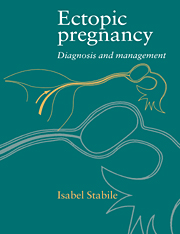Book contents
- Frontmatter
- Contents
- 1 Incidence, aetiology and pathophysiology of ectopic pregnancy
- 2 Clinical presentation of ectopic pregnancy
- 3 Biochemical diagnosis of ectopic pregnancy
- 4 Ultrasound diagnosis of ectopic pregnancy
- 5 Surgical diagnosis
- 6 Practical management of suspected ectopic pregnancy
- 7 Extratubal and unusual ectopic pregnancies
- 8 Medical treatment of ectopic pregnancy
- 9 Conservative and expectant management of ectopic pregnancy
- 10 Radical surgery
- 11 Pregnancy after ectopic pregnancy
- Epilogue: the future
- Index
11 - Pregnancy after ectopic pregnancy
Published online by Cambridge University Press: 26 March 2010
- Frontmatter
- Contents
- 1 Incidence, aetiology and pathophysiology of ectopic pregnancy
- 2 Clinical presentation of ectopic pregnancy
- 3 Biochemical diagnosis of ectopic pregnancy
- 4 Ultrasound diagnosis of ectopic pregnancy
- 5 Surgical diagnosis
- 6 Practical management of suspected ectopic pregnancy
- 7 Extratubal and unusual ectopic pregnancies
- 8 Medical treatment of ectopic pregnancy
- 9 Conservative and expectant management of ectopic pregnancy
- 10 Radical surgery
- 11 Pregnancy after ectopic pregnancy
- Epilogue: the future
- Index
Summary
Introduction
In this chapter we shall consider the outcome after treatment for ectopic pregnancy in terms of rates of conception, live births, abortions and recurrent ectopic pregnancy. One of the problems of reviewing reproductive performance after ectopic pregnancy is that there are numerous comparisons to be made, e.g. conservative versus radical surgery, laparoscopic versus open procedures at laparotomy, laser versus endoscopic techniques, salpingotomy versus segmental tubal resection or fimbrial expression. As elegantly described by Kadar (1990), many of the studies purporting to address this issue confuse these comparisons, such that meaningful conclusions cannot be easily drawn. In essence, what the practitioner needs to know is which procedure gives the best results in terms of future fertility, after allowance for other factors (quite apart from the surgical variables listed above) which are known to influence prognosis.
Precautions to be taken when analysing the results
Several precautions should be taken in analysing reproductive outcome data. These will be described by reference to the results of fimbrial evacuation (Langer et al., 1987; Sherman et al., 1987). First, two treatment modalities should be compared by intention to treat, rather than by actual treatment used. This principle is not always followed. For example, in the study by Sherman et al. (1987), 31 patients underwent successful fimbrial evacuation in a 13-year period; however, in an unspecified number the procedure was attempted but failed because of technical difficulties.
- Type
- Chapter
- Information
- Ectopic PregnancyDiagnosis and Management, pp. 137 - 151Publisher: Cambridge University PressPrint publication year: 1996



